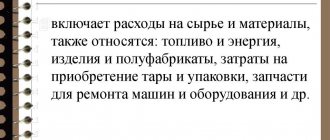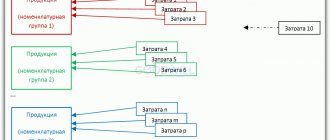What is account 20 used for in accounting?
Existing standards establish that all costs for the production of products, provision of services or performance of work until the completion of the established process are subject to reflection on account 20.
Here the accumulation of expenses associated with the main activity for which the company was created occurs. Therefore, it is called account 20 “Main production”.
All costs accumulated on this account are called work in progress. This is due to the fact that the invoice reflects them until the moment when they form the cost of the product.
This account is used in almost every enterprise, regardless of the field of activity, with the exception of trade. These can be industrial, agricultural enterprises performing construction and installation work, transport and communications, etc.
If a company creates finished products, then closing account 20 means that it is produced. For works and services, closing the 20th account implies that the entity has provided or fulfilled the obligations stipulated by the agreements.
Attention! For small businesses, a simplified accounting procedure is provided, which implies that all company expenses should be taken into account in account 20. Other accounts (23,25,26) are not applied in this case.
Accounting for information about incurred costs on account 20 is carried out on the basis of supporting documents and is used by management to manage the business entity.
How to close account 20 - postings
Before writing off the amounts accumulated on the register, it is necessary to distribute and reset the associated costs:
- Auxiliary production (account 23);
- General production expenses (account 25);
- Defects in production (account 28).
If an organization produces one type of product, then, prior to the closure of the 20th account, the collected costs are fully allocated to work in progress. If products are produced in an assortment or several types of work are performed, then costs are included in the cost proportionally according to the accepted method:
- Regarding revenue;
- Comparison of planned prices;
- Simultaneously according to two indicators.
Example
The company built a garage and hangar for customers in January. Planned prices are 50,000 and 100,000 rubles. respectively. General production expenses (salaries, depreciation, transport, etc.) amounted to 30,000 rubles, materials - 25,000 and 70,000, respectively.
How to close account 20 - postings:
| Debit | Credit | Sum | Operation |
| 10 000 | Costs related to garage | ||
| 20 000 | Hangar related costs | ||
| 5 000 | Damaged metal when welding a garage door | ||
| 25 000 | Materials written off within a month | ||
| 70 000 |
After calculating the full cost of the objects, the accountant will close account 20, the postings of which are based on the implementation method:
| Debit | Credit | Sum |
| 40 000 | The cost of the garage is reflected | |
| 90 000 | The cost of the hangar is reflected |
With the direct and intermediate methods, registers are adjusted from which the cost of objects at the time of sale was previously written off at planned prices. An example of how to close account 20 – correction postings:
| Debit | Credit | Sum | Operation |
| Direct option | |||
| Reversal – 10,000 | Garage | ||
| -10 000 | Hangar | ||
| -20 000 | Corrected the cost of work performed | ||
| Intermediate option | |||
| 150 000 | Planned cost of objects | ||
| 130 000 | Actual amount | ||
| -20 000 | Implementation adjustments | ||
With automatic accounting, the necessary account assignments are made by the program. You need to know how to close account 20 and make manual entries to resolve unforeseen situations.
Regular operations written by programmers are based on standard accounting rules and software features. Before ending the month, you need to make sure that the settings are correct, otherwise the 20th account will not be closed. If you don’t have time to find out and eliminate the causes, you can use an alternative option - independently carry out regulations upon completion of the production process.
Postings for closing account 20 are manually organized through the “Operations” menu. But it is advisable to set up the program for automatic processing, since in the future errors may occur when re-posting documents. The accounting algorithm uses cost accumulation registers, rather than numbers from costing accounts.
Accounting account 20 is the active calculation account “Main production”. Using simple examples for dummies, let's look at typical transactions for account 20 in accounting, as well as what transactions are used to close account 20.
What is included in the account
Account 20 reflects all costs associated with the main activity of the company.
Therefore, the following expenses should be taken into account on the account:
- Material costs are the cost of raw materials, materials, semi-finished products, fuel and others spent on production, that is, what forms the basis of the finished product.
- Costs of services and work of third-party companies involved in the creation of the finished product.
- Remuneration of key personnel with mandatory contributions to extra-budgetary funds.
- Depreciation charges for fixed assets involved in the creation of the finished product.
- Indirect costs that are superimposed on the cost of the finished product - costs of auxiliary production, non-production, factory overhead, sales costs, etc. - they should be reflected on account 20 in the case when the accounts for their accounting are closed at the end of the reporting period.
- Other costs for the production of finished products (taxes, duties, etc.)
The first items relate to direct costs - those that are directly related to production. The cost of the above expenses accumulates while the production process is taking place, and upon its completion they are all written off from account 20 to the cost of the finished product, work, service.
Attention! If the product did not pass technical control and was recognized as a manufacturing defect, the costs of its production previously recorded on account 20 should be written off to the production defect account (usually 28).
Characteristics of account 20 “main production”
Account 20, according to the current Chart of Accounts, is active, since the company’s assets are reflected on it. It has a debit balance reflecting the cost of work in progress, that is, costs that have not yet formed the cost of a product or service.
Debit turnover reflects the expenses incurred by a business entity for the production of finished products, provision of services or performance of work. The credit of the account records the cost of production written off for finished products.
The balance at the end of the reporting period is determined by summing the balance at the beginning and the turnover on the debit side of the account and subtracting from it the turnover on the credit side of the account.
Attention! Many business entities, especially those who provide services and work, have a balance of 0 at the end of the reporting period for account 20.
However, this rule does not apply to organizations engaged in production activities. For them, this indicator reflects the products launched into production.
You might be interested in:
Write-off of receivables in an organization with an expired statute of limitations: procedure
Main characteristics
There are accounts that must be closed at the end of the period, since they reflect the results of business activities that form profits and losses. These include account 20 “Main production”.
The name of the account speaks for itself - it reflects the main activities of the enterprise, that is, direct costs for the formation of the cost of products (works, services).
From the author! It doesn’t matter whether the company is producing products or providing services, the main condition for using the 20th account is the presence of a core activity.
The costs of producing products (works, services) are accumulated in the debit of the account. In addition to expenses, there is the material value of work in progress.
When the work is completed, the loan account is closed. However, this may be the detection of a manufacturing defect. In such cases, 20 must be closed for the amount of unusable goods:
- Dt 28 “Defects in production” Kt 20 “Main production”.
Direct expenses that are usually attributed to account 20:
- Purchase of raw materials and materials involved in the production process.
- Remuneration and contributions to the budget of production workers.
- Repair and depreciation of production equipment.
- Expenses for modernization and innovation.
- Other costs.
20 is essentially active. Closing account 20 using manual operations is a long and labor-intensive process, since analytical accounting is deployed on it:
- according to the nomenclature that contains types of activities;
- by department;
- by cost items;
- on the work of production programs (if there are investment projects).
What subaccounts are used?
Analytical accounting on account 20 is usually carried out by types of products produced, services provided, work performed, divisions existing in organizations, as well as by types of costs. For example, in agriculture it is customary to open sub-accounts “Crop production”, “Livestock production”, “Industrial production” and others.
Account 20 may have the following subaccounts by type of cost:
- "Depreciation".
- "Labor costs."
- "Material costs."
- “Deductions for social needs.”
- "Other expenses."
Attention! On account 20, it is possible to keep track of costs at standard cost with a separate accounting of excess costs. Then a sub-account “Excessive costs” can be opened.
Account balance 20 “Main production”
At the end of the reporting period, the organization identifies and writes off the cost of production on account 20 “Main production”. As a result of these activities, a debit balance may be formed. This indicator reflects how high the cost of the work in progress is. The resulting amount on the 20th account should be transferred to the next month.
How to properly organize accounting of work in progress and how its indicators are entered into the balance sheet, you can learn from the material “Main production in the balance sheet (nuances).”
Account correspondence
Account 20 can correspond with the following accounts.
From the debit of account 20 to the credit of accounts:
- Account 02 - regarding write-off of depreciation on fixed assets;
- Account 04 - when writing off depreciation of intangible assets without using account 05;
- Account 05 - regarding depreciation of intangible assets;
- Account 10 - regarding the write-off of materials for production;
- Account 11 - regarding the write-off of fallen or slaughtered animals;
- Account 16 - regarding the write-off of deviations in the cost of materials;
- Account 19 - regarding the write-off of non-refundable VAT;
- Count 20 - for internal movements of products in production;
- Account 21 - regarding the write-off of own semi-finished products for production;
- Account 23 - regarding the write-off of auxiliary production costs to the main production;
- Account 25 – regarding the write-off of general production costs for main production;
- Account 26 – regarding the write-off of general business expenses for the main production;
- Account 28 - regarding the return to production of products with corrected defects or the write-off of irreparable defects;
- Account 40 - when using products for the needs of main production;
- Account 41 – when using purchased goods for the needs of the main production;
- Account 43 – when using main products for the needs of main production;
- Account 60 - when included in the cost of suppliers' services;
- Account 68 - regarding the inclusion of certain taxes in the cost price;
- Account 69 - regarding accrued social contributions for key workers;
- Account 70 – regarding accrued wages for main employees;
- Account 71 - write-off of accountable amounts for production needs;
- Account 75 - in terms of acceptance as a contribution to the authorized capital of unfinished products;
- Account 76 - regarding the write-off of other services;
- Account 79 - when taking into account the costs of branches or separate divisions in the cost price;
- Account 80 - when contributing to a friend’s capital with products in the work-in-progress stage;
- Account 86 - in terms of receiving as targeted financing an object with work in progress;
- Account 91 - when accepting for accounting unfinished products identified by inventory;
- Account 94 - Regarding the write-off of identified shortages and losses for production;
- Account 96 - regarding the accrual of contingent liabilities;
- Account 97 - regarding the write-off of deferred expenses for production.
According to the credit of the account, it corresponds with the debit of the following accounts:
- Account 10 – regarding the return of materials from production to the warehouse;
- Account 11 - When reflecting the offspring of animals;
- Account 15 - when forming the cost of raw materials from own production;
- Count 20 – for internal movements of products in production;
- Account 21 - When reflecting semi-finished products of own production;
- Account 28 - when taking into account product defects;
- Account 40 - when posting products at planned cost;
- Account 43 - when recording products at actual cost;
- Account 45 - when writing off the cost of products, which in this case cannot be recognized in accounting;
- Account 76 - regarding the write-off of expenses due to other services;
- Account 79 - regarding the reflection of costs by structural divisions or branches;
- Account 80 - when returning a share to a friend at the expense of unfinished products;
- Account 86 - when writing off target financing funds after paying expenses;
- Account 90 - when writing off cost by direct sale;
- Account 91 - when writing off the cost of unfinished orders upon their cancellation;
- Account 94 - when identifying shortages and losses in production;
- account 99 - when writing off production costs in emergency situations.
You might be interested in:
Account 90 in accounting: what is it used for, characteristics, examples of postings
Procedure for closing an account
The method by which account 20 is finally closed must be specified in the accounting policy. In addition, if this is necessary, the distribution base is indicated in the same document.
There are three ways in which you can close your account 20.
Direct method
During the billing period, the cost of production cannot be determined. In this case, products that have already left production should be accounted for at some conditional prices. After the month is closed, the cost of output is adjusted to the actual level.
When using this method, it is not possible to determine the actual cost during the billing month.
Intermediate method
When using this method, account 40 “Product Output” is used in accounting. It records the planned cost (on the credit of the account) from the actual cost (on the debit of the account). After the month is completed, the amount of deviations is proportionally written off to accounts 43 and 90.
Direct sale of manufactured products
With this option, the created products do not remain in the warehouse, but are sold immediately from production. In this situation, all production costs are immediately transferred to cost of sales account 90. Typically, service costs are closed in this way.
Examples of accounting entries
The following transactions can be made with this account:
| Debit | Credit | Content |
| Postings for accumulating costs | ||
| 20 | 02 | Accrued depreciation of fixed assets |
| 20 | 04 | Write-off of depreciation of intangible assets if account 05 is not used |
| 20 | 05 | Depreciation of intangible assets accrued |
| 20 | 10 | Materials and components written off for production |
| 20 | 11 | Cost of animals written off |
| 20 | 16 | Variance in materials cost written off |
| 20 | 19 | Non-refundable VAT amounts are written off to the cost price |
| 20 | 20 | Turnover within production |
| 20 | 21 | Transfer of self-made semi-finished products into production |
| 20 | 23 | The costs of auxiliary production are written off to the main production |
| 20 | 25 | The cost includes general production costs |
| 20 | 26 | The cost includes general business expenses |
| 20 | 28 | Losses from defects are written off to cost |
| 20 | 29 | Services of servicing industries are written off as main production |
| 20 | 41 | Goods for resale were used for own needs |
| 20 | 43 | Finished products were used for our own needs |
| 20 | 60 | Utilities costs written off for production |
| 20 | 68 | Taxes are written off against the cost price |
| 20 | 69 | Calculation of social contributions on the basic salary |
| 20 | 70 | Payroll for key employees |
| 20 | 71 | Amounts of accountable persons are written off for production |
| 20 | 76 | The cost includes services from other suppliers (for example, insurance) |
| 20 | 79 | The cost includes the costs of branches or separate divisions |
| 20 | 94 | Shortages and losses are written off to cost |
| 20 | 96 | The cost reflects the formation of a reserve for future expenses |
| 20 | 97 | The cost includes amounts of deferred expenses |
| Postings to write off expenses | ||
| 10 | 20 | Return of unused materials from production to warehouse |
| 11 | 20 | Increasing the number of animals due to weight gain |
| 21 | 20 | Own semi-finished products accepted for accounting |
| 28 | 20 | Main production defect reflected |
| 40 | 20 | Capitalization of finished products at planned cost |
| 43 | 20 | Capitalization of finished products at actual cost |
| 90 | 20 | Actual cost of work written off |
| 94 | 20 | Deficiencies identified in the main production are reflected |
| 99 | 20 | Writing off expenses due to an emergency |
Methods for accounting for raw materials at the dealer
The agreement has been signed, and further reflection of the stages of transformation of raw materials into a finished product is required. The accounting records of the owner (customer) are formed as follows:
| Debit | Credit | Operation stage |
| 10-7 | 10 | Purchased materials were sent for recycling |
| 10 | 10-7 | The balance of raw materials unused by the contractor was capitalized |
| 20,23,29 | 10-7 | The cost of recycled materials is written off to production |
| 20,23,29 | 60,76 | The cost of services provided under the contract is taken into account without VAT |
| 19-04 | 60,76 | The amount of VAT presented by the service provider is reflected |
| 68-02 | 19-04 | The VAT amount is deductible |
| 43 | 20,23,29 | Finished products are received |
| 60,76 | 51 | The relevant services to the contractor have been paid |
Accounting for processing of raw materials by the processor:
| Debit | Credit | Operation stage |
| 003-1 | Materials accepted at cost according to transfer documents | |
| 003-2 | Raw materials transferred for processing | |
| 20-2 | 02,10,70,69 | Processing costs are taken into account (wear and tear, wages, payroll contributions) |
| 20-2 | 60,76 | The amount of costs (excluding VAT) incurred by attracting third parties |
| 19-3 (19-4) | 60,76 | The amount of input tax is reflected |
| 003-2 | The cost of consumed materials is written off | |
| 003-1 | The cost of returned materials is written off | |
| 62,76 | 90-1 | Revenue from work and services performed |
| 90-3 | 68-2 | VAT charged |
| 90-2 | 20-2 | The total costs of performing work and services are taken into account |
| 51 | 62,76 | Payment received from the customer |
| 002 | The cost of products to be reimbursed in case of damage or loss | |
| 002 | Cost of products transferred to the customer |
Why account 20 is not closed in 1s 8.2 and 8.3 in accounting
Sometimes an accountant may have a situation when he closes account 20 in 1s 8.3, but after the operation there is a balance left on the account.
Typically, the cause of such an error is incorrect information in the accounting documents on costs.
The thing is that when closing, costs are distributed according to analytics by item groups. This means that the cost analytic attribute must be set to the same as that of the item group. The program performs the distribution within the group proportionally.
Attention! If any cost's analytics attribute does not match any of the products produced, it hangs on the account. To resolve the error, you need to open the “Analysis of subconto Item groups” report and see for which group the costs remain.
Operations in software products
When performing automatic regulatory operations in 1C, you should remember that all analytics must be registered when creating primary documents. Otherwise, it will not be possible to carry out the routine operation, since all unfilled subcontos will result in numerous errors:
- production of products, provision of services or balances of work in progress are not reflected;
- the order of divisions is not established;
- cost analytics is not completed;
- the counter issue accounting register is not filled in;
- the distribution base for indirect costs has not been specified.
If an error occurs, you need to go through the documents and fill in the missing analytics. To make it easier to understand, you can watch the video:
To create an operation in 1C 8 versions 2.0 and 3.0, you need to go to the “Accounting, Taxes and Reporting” menu, the “Period Closing” section, the “Month Closing” submenu or “Routine Operations”. But before you create the operation “Closing accounts 20, 23, 25, 26”, you must complete the previous operations.
You need to perform “Re-posting documents for the month”, then reflect wages, reserves, depreciation, etc.
Figure 1. Monthly closing sequence
The direct implementation method is suitable for automatic closing in 1C Enterprise 8.2 and 8.3. In order for the program to close more complex methods, you will have to make the appropriate settings.
For tax accounting purposes, all direct expenses are included in the formation of the income tax base. In order for the tax to be calculated correctly, you need to configure the directory in 1C “Direct Expenses”. If any costs are not included in the list, the program will automatically display them in 90.08 “Administrative expenses”.
1C UPP contains a mechanism for distributing costs, carried out using production documents or special processing “Calculation of cost”. With the direct distribution method, this will be “Production report for the shift”, “Distribution of materials for production”. With the indirect method - “Calculation of cost”.
In 1C version 7.7 there is also a “Month Closing” menu. In order for the automatic completion of the period on the 20th account to occur here, you need to check the box in the line “Calculation and adjustment of the cost of GP and PF”. Documents used by the accounting department when maintaining the production cycle:
- Transfer of materials to production.
- Transfer of materials into operation.
- Transfer of finished products to the warehouse.
The accounting algorithm affects the possibility of conducting manual or routine operations, since the slightest violation of the order will not allow the account to be closed correctly.






